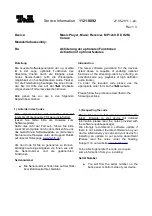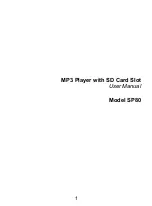
3
CFD-RS60CP
TABLE OF CONTENTS
1.
SERVICING NOTES
...............................................
4
2.
GENERAL
...................................................................
5
3.
DISASSEMBLY
3-1.
Cabinet Top Assy .............................................................
7
3-2.
Cabinet Front Assy, Cabinet Bottom Assy ......................
7
3-3.
Wires ................................................................................
8
3-4.
MD Block ........................................................................
8
3-5.
Holder (Cassette) .............................................................
9
3-6.
Power Key Board .............................................................
9
3-7.
Main Board Section, Headphone Board .......................... 10
3-8.
Tuner Board, Power Board .............................................. 10
3-9.
CD Lid ............................................................................. 11
3-10. LCD Block Assy, USB Connect Board ........................... 11
3-11. CD Block Assy ................................................................ 12
3-12. R/P Head (HRP301), Erase Head (HE301), TC Board ... 12
4.
MECHANICAL ADJUSTMENTS
....................... 13
5.
ELECTRICAL ADJUSTMENTS
Tape Section .................................................................... 13
Tuner Section ................................................................... 14
CD Section ...................................................................... 16
6.
DIAGRAMS
6-1.
Block Diagram – CD Section – ....................................... 17
6-2.
Block Diagram – Tuner Section – ................................... 18
6-3.
Block Diagram – USB Section – ..................................... 19
6-4.
Block Diagram – Main Section – .................................... 20
6-5.
Printed Wiring Board – BD91 Section – ......................... 22
6-6.
Schematic Diagram – BD91 Section – ............................ 23
6-7.
Printed Wiring Board – Tuner Section – ......................... 24
6-8.
Schematic Diagram – Tuner Section – ............................ 25
6-9.
Printed Wiring Board – Main Section – .......................... 26
6-10. Schematic Diagram – Main Section (1/2) – .................... 27
6-11. Schematic Diagram – Main Section (2/2) – .................... 28
6-12. Printed Wiring Boards – Power Section – ....................... 29
6-13. Printed Wiring Boards
– Headphone/USB Connect/VOL Section – ................... 30
6-14. Schematic Diagram
– Headphone/USB Connect/VOL Section – ................... 31
6-15. Printed Wiring Board – USB Section – ........................... 32
6-16. Schematic Diagram – USB Section – .............................. 33
6-17. Printed Wiring Board – TC Section – .............................. 34
6-18. Schematic Diagram – TC Section – ................................ 35
6-19. Printed Wiring Boards – Key Section – ........................... 36
6-20. Printed Wiring Board – LCD Section – ........................... 37
6-21. Schematic Diagram – Control Section – ......................... 38
7.
EXPLODED VIEWS
7-1.
Cabinet Section ................................................................ 50
7-2.
Cabinet (Front) Section ................................................... 51
7-3.
Cabinet (Top) (1) Section ................................................ 52
7-4.
Cabinet (Top) (2) Section ................................................ 53
7-5.
Cabinet (Bottom) Section ................................................ 54
7-6.
Tape Mechanism Section (MF-S350V) ........................... 55
8.
ELECTRICAL PARTS LIST
................................ 56
UNLEADED SOLDER
Boards requiring use of unleaded solder are printed with the lead-
free mark (LF) indicating the solder contains no lead.
(Caution: Some printed circuit boards may not come printed with
the lead free mark due to their particular size)
: LEAD FREE MARK
Unleaded solder has the following characteristics.
•
Unleaded solder melts at a temperature about 40 ˚C higher
than ordinary solder.
Ordinary soldering irons can be used but the iron tip has to be
applied to the solder joint for a slightly longer time.
Soldering irons using a temperature regulator should be set to
about 350 ˚C.
Caution: The printed pattern (copper foil) may peel away if
the heated tip is applied for too long, so be careful!
•
Strong viscosity
Unleaded solder is more viscous (sticky, less prone to flow)
than ordinary solder so use caution not to let solder bridges
occur such as on IC pins, etc.
•
Usable with ordinary solder
It is best to use only unleaded solder but unleaded solder may
also be added to ordinary solder.




































